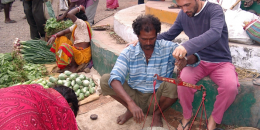Ho ritrovato l’articolo che mi aveva dato Dipankar Gupta, sociologo abbastanza noto che ho incontrato più volte a new delhi, ha studiato molto le trasformazioni dell’India rurale. Questo articolo, scritto lo scorso gennaio, fa delle roflessioni impietose verso i maoisti. Si può essere o meno d’accordo con alcune cose (ad esempio su come taglia corto sulla questione del legame tra gli adivasi e la terra), ma trovo che ponga questioni molto utili: a partire dal fatto che non basta la povertà a spiegare l’esistenza della ribellione maoista, spiega molto di più lo stato di assenza del diritto e illegalità rampante nelle regioni adivasi.
Marina Forti
The Maoist Cover
by Dipankar Gupta
If poverty causes Maoism, then it should have been everywhere. Poverty is not limited to the tribal tracts of Jharkhand and Chattisgarh. Why don’t the non-tribal poor motivate Maoists in the same way?
There are two reasons for this and none of them flattering to Maoists.
First, the forested tribal belt of India is not easily visible to the public eye. These are not places that produce foreign secretaries, major scientists, business icons, fashion designers, news moguls, or even movie stars. These notables come from the fertile landlord-peasant regions of the plains where there is greater public scrutiny on a daily basis. None of them come from the tribal hinterlands.
Why then should Maoists take to the forests forsaking the plains where there are more rich and poor, land magnates and peasants? Old fashioned Maoism should certainly have led them in that direction, as would have Mao himself.
The truth is that it is not poverty alone that has drawn Maoists to the tribal tracts. There is grueling poverty practically everywhere in India: in districts as far away as Bathinda, Jaunpur, Narmada or Yevetmal are from one another. The 59th Round of the National Sample Survey found rural poverty to be so chronic and pervasive that one doesn’t have to visit tribal jungles to get wind of this. In Andhra Pradesh, for example, three out of every four farmers is writhing in debt. Agriculturalists here are so poor that one bad harvest can wipe them out and drive many to suicide.
Over the past forty years agricultural poverty has worsened so sharply that even officials have been shamed. During this period, regardless of population growth, there has been a decline of about 25% in the area under agricultural operation. Who would have imagined this possible? The National Sample Survey also finds that most holdings are self operated which basically means that landlords and sharecroppers are largely history today.
Yet there are poor farmers everywhere who continue to drudge on small parcels of land. Big farmers, such as they are, can be found in greater numbers in Punjab and Rajasthan, but there are no Maoists there. Instead, their presence is greater in Bihar and Bengal where big landowners are practically extinct. Only 0.07% of land holdings in Bihar and an even smaller percentage of 0.01% in Bengal qualify as large holdings. No wonder many Bengali Maoists address Mamata Banerjee as Didi!
To complicate matters, the elders of today’s tribals remained quiescent when steel plants were being set up in Bokaro and Bhilai through the fifties and sixties. These were established in prime tribal properties of Jharkhand and Chattisgarh, respectively, yet there was no Maoism then. Naxalbari with its political heavies could make no dent in this region. It is, therefore, not poverty, nor the dispossession of tribal lands, that has filled Maoist sails.
Could it be that we have romanticized tribal attachment to land? There are Jharkhandis in carpet manufactories of UP, in textile units in Panipat and even in the hosiery industry in distant Tirupur, near Coimbatore. Many of them would happily swap the shade of their sacred grove for a spot in the capitalist sun. Also Jharkhand is a mono crop area and tribals routinely leave their homes after the paddy season in search of work elsewhere in the country. They have been doing this for a long time. Now that there are more non-agricultural opportunities, this tendency to migrate is even stronger.
That, however, is not all. If the Maoists function best in areas where the national elite and the mainstream economy are noticeably absent, they are not alone in this. It is in the same geographical terrain where sleazy commercial agents, miners and timber merchants make crores by calmly flouting every law in the book. That they can do all this blatantly is because, like the Maoists, they too operate on the blind side of the national elite that rules the plains. It would need a spectacular effort to report on regions where these underground merchants rule; it could also be dangerous one. These are not places that are in the public glare on a routine, everyday basis. Aerial surveys are fine, but high level government officials are often advised against actually visiting Maoist areas at ground level.
The factors then that support the Maoists also help the worst specimens of commerce. If that is so, are the two connected? Or is it just a coincidence?
We are now able to appreciate the second reason why Maoism does well only in tribal India. Can carriers of the radicals may object, but corrupt business needs Maoists, especially their lookalikes, as much as the latter needs them. Posco and Vedanta are the more respectable versions of the kinds of interests that are looting India’s natural resources, much of it in tribal India. Open cast mining and wanton felling of Sal confronts one at nearly every turn in hilly Jharkhand. The way these operations are carried out would have been difficult to accomplish in the plains. Corrupt though much of India is, what happens in the tribal belt raises the bar to an altogether different level.
Without getting into the question of who came first, the resource plunderers or the Maoists, a section of erstwhile revolutionaries soon sense their opportunity. They sever their ties with their foundational ideology without much heartburn. Many of them had joined the Maoist movement for selfish gains, personal prominence, or to extract revenge. In time they begin to thrive on the “taxes” and protection money they exact from mining and timber operators. That they already have the gun gives them a head start in this business.
Gradually, the rift between Maoists widens, quite unbeknownst to the outside world. The more committed Maoists retreat into remoter forest regions with their faithful, leaving the field open for the renegades among them. They exploit the ideological shiver that the very mention of Maoism has on the general public to cozy up with commercial thugs and function as armed parasites. From this time on Maoism begins to provide the kind of opaque cover that unsavoury entrepreneurs were on the lookout for. The greater the reportage of Maoist violence the thicker the cover gets. Naturally, such a combine soon finds de facto political representatives, like Shibu Soren, who guard them from legal interventions.
Maoism, therefore, is not just a function of economic poverty but of informational poverty as well. To argue then that poverty removal will take care of Maoists actually begs the issue. Strafing and bombing Maoist regions will probably kill a few committed activists and a lot of poor tribals, but will leave the problem quite intact. If the state is really serious about Maoism it should not want to fight poverty as much as the nexus between commerce and mercenaries who will kill without a cause. It is this combine that needs to be broken. This is the hard line. The soft approach is to talk sweetly about poverty. Does one have to visit tribal India for a head count of the poor?
If Mao had been given a decent burial, and not stiffly embalmed, he would probably be turning in his grave.


